Glacier Park Fires
Includes a Brief History of Glacier Park Fires, and How To Enjoy Glacier Park During the Annual Fire Season.
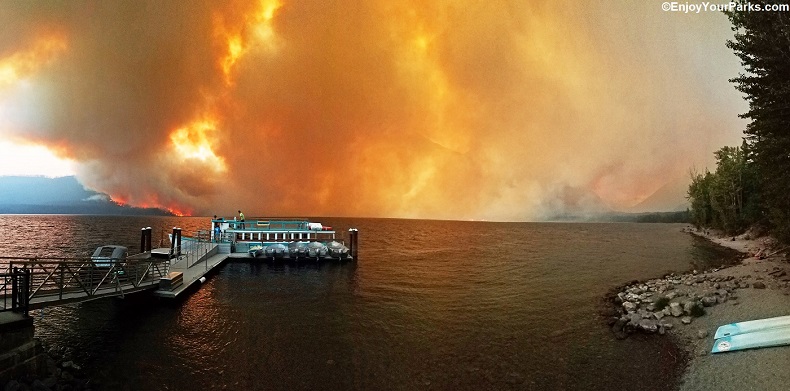
Howe Ridge Fire August 12, 2018 in Glacier National Park.
Glacier Park Fires
Includes a Brief History of Glacier Park Fires, and How To Enjoy Glacier Park During the Annual Fire Season.

Howe Ridge Fire, during the evening of August 12, 2018. 7 homes and 12 historic cabins were destroyed.
The recent Glacier Park fires that have made the headlines in recent years is the Red Eagle Fire (2006), Reynolds Creek Fire (2015), Sprague Fire (2017), Kenow Fire (2017) and the Howe Ridge Fire (2018). But what’s interesting is the fact that Glacier National Park has had at least one forest fire every summer since it’s creation in 1910 except for one year: 1964. Fortunately most of the these Glacier Park fires did not lead to massive timber loss or destruction of homes or other buildings, but through the years there have been some “whoppers”.
In this section of our website, we want to give you a brief history of Glacier Park fires, as well as some tips on how to enjoy Glacier National Park during it’s annual fire season, when the air quality at times can be quite smokey.
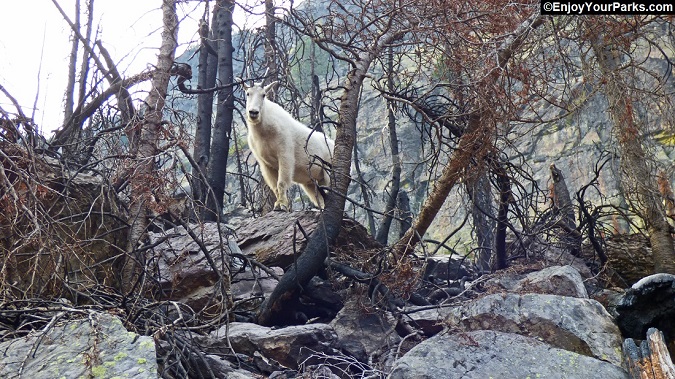
Mountain Goat assessing the aftermath of the Sprague Fire of 2017.
Glacier National Park is known for its crystal clear air and pristine landscapes. And for most of the year, this is true. However, once the Glacier Park fire season begins, typically the first week of August, then those crystal clear skies can become quite hazy at times, depending on the location of the fire or fires, and the wind direction. Glacier Park fires, fires located in the immediate area near Glacier Park, and fires burning hundreds if not thousands of miles away, all can dramatically affect the air quality during your Glacier Park vacation.
During your Glacier Park vacation, there may not be any Glacier Park fires, but there could be forest fires in the surrounding ares, or in Washington, Oregon or California, or British Columbia... and if the wind is wrong, the skies in Glacier National Park will be as smoky and hazy just as if the fire was over the next ridge. So during the "fire season" of August through the end of September, forest fires may affect your visit, even if Glacier Park is not directly experiencing forest fires.
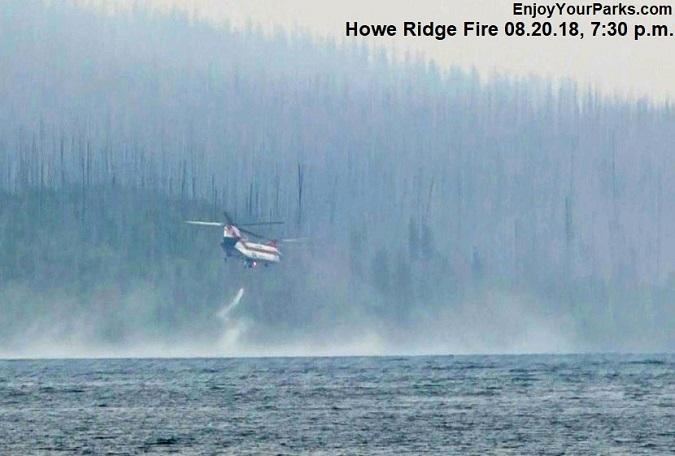
Helicopter working on the Howe Ridge Fire along Lake McDonald in Glacier Park, 2018.
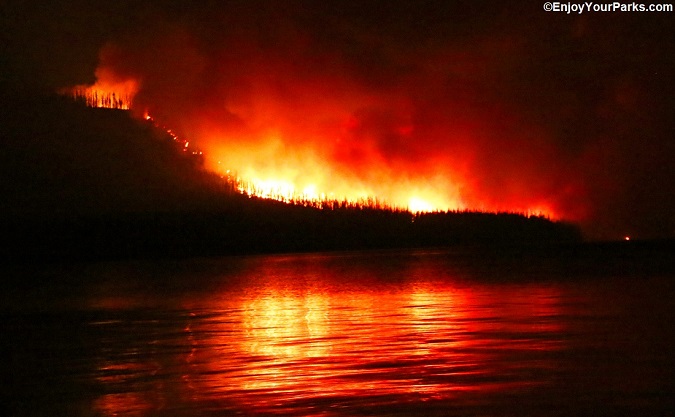
Howe RIdge Fire on the evening of August 12, 2018. 7 homes and 12 historic cabins burned to the ground.
When Does The Glacier Park Fire Season Begin?
During a typical year, the official "fire season" in and around Glacier Park begins the first week of August. Of course each year is different, as it depends on where the fires are located and how much precipitation the area gets throughout the summer. And keep in mind, even if there are no Glacier Park fires burning, the immediate area may have fires burning, or even the West Coast... all of which can affect the air quality of Glacier Park.

These photos illustrate the difference between the clear air of Glacier Park BEFORE the fire season begins as compared to smoky day during the annual Northern Rocky Mountain fire season.
When Does The Glacier Park Fire Season End?
Glacier Park Fires usually are completely put out sometime in October, and at the latest November. This of course depends on the extent of the fall weather, which is different every year. But by mid October, Glacier Park typically begins to get a fair amount of precipitation in the form of rain and snow, and the temperatures, especially at night dip well below freezing. By then the fires are no longer growing and are no longer a threat. And because of the dramatic reduction of fire activity due to the cold temps and wet weather, the air quality usually returns to normal.
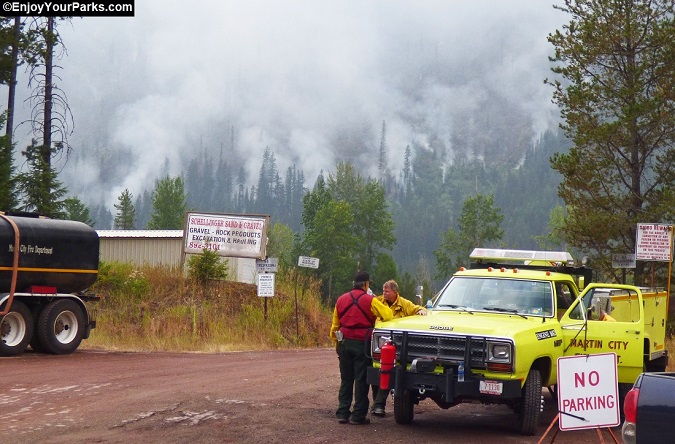
Paola Ridge Fire along U.S. Highway 2 during the summer of 2018.
Is One Good Storm Enough to put out the Glacier Park Fires?
The answer to that question unfortunately is "No". It has always amazed us just how much precipitation it takes to completely put out Glacier Park fires. For example, the Sprague Fire of 2017 was hit hard in the third week of September with an above average amount of snow and rain, and the temperatures were well below average for this time of year. But even with this unseasonally cold and wet autumn season, there were still "hot spots" that continued to smolder well into the first and second weeks of November. Again, the threat of Glacier Park Fires continuing to grow greatly diminishes once the temperatures drop and the precipitation begins to fall steadily. It is then that the growth of these fires stop and the threat of more destruction is no longer an issue. October is in other words, the "sigh of relief" month, as most Glacier Park fires are laid to rest by then.
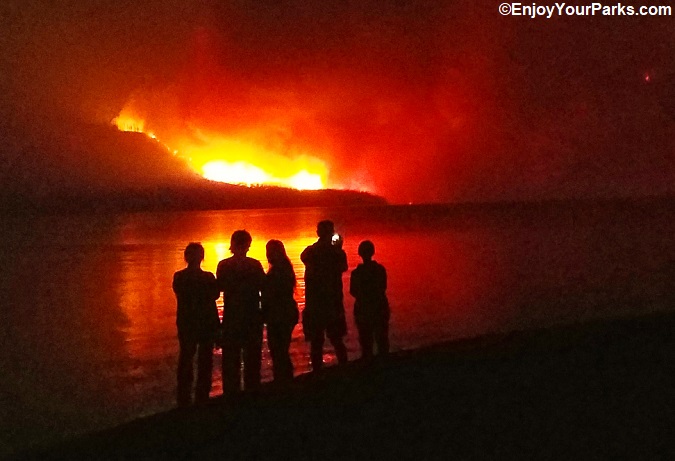
Visitors watching the Howe Ridge Fire on Lake McDonald on August 12,2018.
Brief History of Glacier Park Fires
1910-1929
Glacier Park fires have played a significant role in transforming the Glacier Park landscape through its 109 year history. Glacier Park is roughly 1 million acres in size, and through the history of the park, fires have come and gone, forever changing the appearance of this remarkable park with each blaze. For example, in 1910, Glacier Parks very first year as a national park, Glacier Park fires burned over 100,000 acres! Then in 1926, over 42,000 acres burned along the west side of Glacier National Park. In 1929 the Half Moon Firethat started near Columbia Falls burned over 100,000 acres in and around Glacier Park.
1936
In 1936, a forest fire known as the Heavens Peak Fire started below Heavens Peak and became a monster, climbing up and over Swiftcurrent Pass and completely wiping out the Many Glacier (Swiftcurrent) Valley. The Many Glacier Hotel was miraculously saved by its loyal employees. The builder and owner of the Many Glacier Hotel was the Great Northern Railway, and when the wire message came through to the main office in St. Paul, railroad officials sent one word back in reply: "Why?" The Great Depression was well underway, and with dwindling ticket sales, the railroad would have been better off cutting its losses from a business perspective (but certainly not from a historical perspective).
1988
Then for many years, Glacier Park was known as the "Asbestos Park" because Glacier Park fires rarely turned into destructive giants, whereas other national parks and even nearby surrounding areas would experience far more aggressive forest fire activity. It seemed that Glacier Park was "immune" to forest fires for quite a spell... until 1988 when all that changed. The Red Bench Fire burned 38,000 acres in what is known as the North Fork Area of Glacier Park. Located along the west side of Glacier Park, a firefighter lost his life in this horrific fire, and 19 others were injured. over 25 homes were destroyed. Overshadowing this fire was of course the Yellowstone Fires of 1988, where nearly 800,000 acres burned and stunned the world.
2001
The Moose Fire of 2001 burned nearly 71,000 acres in the North Fork Area of Glacier National Park. More specifically, the Camas Creek Area and the surrounding acreage. This monster fire's path can still easily be seen along the Camas Road, where young trees are now beginning to take hold again.
2003
The largest and most destructive Glacier Park fire season was in 2003, where 13% (130,000 acres) of Glacier National Park burned. Known as "The Big Burn", this horrific Glacier National Park fire season will hopefully never be repeated (knock on wood). One of these massive fires was the Roberts Fire, which burned a vast area of nearly 58,000 acres that included most of the west (northwest) side of Lake McDonald. Another large forest fire that took out Glacier Park's Flattop Mountain and the Loop Trail, and threatened the Granite Park Chalet was the Trapper Peak Fire, which was over 18,000 acres in size. The Rampage Fire burned out the Park Creek and Coal Creek drainages, and reached 26,000 acres in size. Other fires also burned in the North Fork Area, just west of Glacier National Park during this epic fire season.
2006
In 2006, a tiny fire started near the head of Red Eagle Lake along the east side of Glacier Park near St. Mary on July 28. The Red Eagle Fire quickly blew up and incinerated over 34,000 acres total, sprawling between Glacier National Park and the neighboring Blackfeet Indian Reservation. After a lengthy investigation, the true cause of the fire was suspicious but was never completely determined beyond a shadow of a doubt. But what it left behind was a terribly scorched forest that is still now struggling to get a foot hold. In many areas of the fire, even 12 years later have only sparse lodgepole pines that are 4 feet tall at most. But hundreds of thousands of dead, white colored trees still stand today as a memorial to this destructive blaze.
2015
2015 marks the year that a scenic portion of the Going To The Sun Road burned in a Glacier Park fire known as the Reynolds Creek Fire. On July 21, 2015 the Reynolds Creek Fire began along Reynolds Creek along the east side of the Going To The Sun Road near St. Mary Lake, and by the time mother nature put it out in the fall it had reached 4, 459 acres. This might not seem like much of a fire, but it’s the “quality” of the area it burned rather than the “quantity”. The Reynolds Creek Fire scorched an incredibly scenic portion of the Going To The Sun Road, which includes the Rising Sun Area, Otokomi Lake Area, Wild Goose Island Overlook Area, St. Mary / Elizabeth Falls Trail, and the Baring Creek Valley Trail (Siyeh Pass) and Sunrift Gorge. This is the first fire in a very long time within the heart of Glacier National Park where visitors must literally drive through a recent forest fire. We think that will be quite eye opening for visitors to discover just how long it takes for a forest to rejuvenate in this part of the country. So the Reynolds Creek Fire is in a way a great teaching tool for everyone, as it's location is "front and center" along the Going To The Sun Road.
The Thompson Fire of 2015 burned over 17,000 acres in the popular Nyack Area, and reached the Continental Divide along the Pitamakan Pass-Dawson Pass Loop Trail in the Two Medicine Area.
2017
A series of dry lightning strikes (meaning, lightning without any rain) struck the evening of August 10th, and ignited approximately 11 spot fires throughout Glacier Park. All but one was put out through massive immediate action by firefighters. The one that got away was the Sprague Fire, which eventually destroyed the historic Sperry Chalet above Lake McDonald Lodge, and threatened the Going To The Sun Road and Lake McDonald Lodge for over 2 months. In the end, both were spared, but vast areas of forest along and beyond Snyder Ridge on the east side of Lake McDonald, including the Sperry Chalet Area, Snyder Lake Area, Lincoln Pass Area, Fish Lake and Lincoln Lake Area were severely scorched. Nearly 17,000 acres burned, much of it a 300 year old growth forest. An early winter-like autumn set in unexpectedly and cooled and dramatically slowed the fire down many weeks before fire officials predicted it would be over. The historic Sperry Chalet, built in 1914 was destroyed but it’s stone walls remained standing. A gallant effort by the Glacier National Park Conservancy and the NPS brought in a team of architects to figure out how to stabilize the walls for the upcoming winter. Even though it was a near record winter, the walls remained standing.

Sprague Fire above Lake McDonald, 2017.

Canadian "Super Scooper" dropping water on the Sprague Fire during the summer of 2017.
Also in 2017, one of the most aggressive and destructive fires in history hit Waterton Lakes National Park. On August 30, a series of lightning strikes started several fires in the area, including the Kenow Fire just west of Waterton Lakes National Park. This fire continued to burn outside of Waterton Lakes National Park for the first 10 days, but on September 11, 2018, the Kenow Fire blasted through the park, incinerating over 45,000 acres in 4 hours. Both major parkways, known as Akamina Parkway and Red Rock Parkway, were destroyed, as well as the Waterton Lakes National Park Visitor Centre. Miraculously, through the efforts of brave firefighters, the Prince of Wales Hotel and Waterton Village were spared.
Over 80% of the forested area and trail system of Waterton Lakes National Park was burned, as well as the large popular campground along Red Rock Parkway. There is no other way of looking at this incident than it being a devastating, crippling blow to this stunningly gorgeous national park. Anyone who's associated with Waterton Lakes National Park or anyone who had visited it in the past, were emotionally crushed that night. There is one thing to be thankful for however, and that is the fire experts had a strong suspicion the fire could make a major run through the park because of the extremely dry conditions, so they evacuated the entire park days prior to the blow up. Otherwise, many people would have undoubtedly lost their lives as the fire burned over 40,000 acres in 4 hours, and was moving over 40 miles an hour, destroying everything in its path, including the wildlife.
2018
The summer of 2018 marked the start of the rebuilding process of the Sperry Chalet after it being destroyed by the Sprague Fire the year before. The main short term goal for the 2018 season was to get the new roof on before winter. We actually visited the chalet on August 9, 2018 to see how the rebuilding was going. But on August 11, 2018, another series of dry lightning strikes ignited several fires in and around Glacier Park, which included the Howe Ridge Fire at Lake McDonald. Before the first day was over, the Howe Ridge Fire blew up along the west side of Lake McDonald, destroying 7 homes and over a dozen historic cabins including Kelly’s Camp and the Wheeler Cabin. The author is writing this as 14 days has now passed, and it is now 11,000 acres and only 10% contained. Other fires include the Paola Ridge Fire along U.S. Highway 2 near Essex Montana, the Whale Butte Fire west of Kintla Lake in the North Fork Area, the Coal Ridge Fire west of Polebridge Mercantile and the Boundary Fire near Goat Haunt Montana and Upper Waterton Lake. These fires will also slow down the rebuilding of the Sperry Chalet, as helicopters needed for supply drops will be now needed for fire fighting.

We snapped this shot on August 9, 2018 of the Sperry Chalet showing the rebuilding process.
WATCH OUR VIDEO OF THE REBUILDING OF THE SPERRY CHALET:
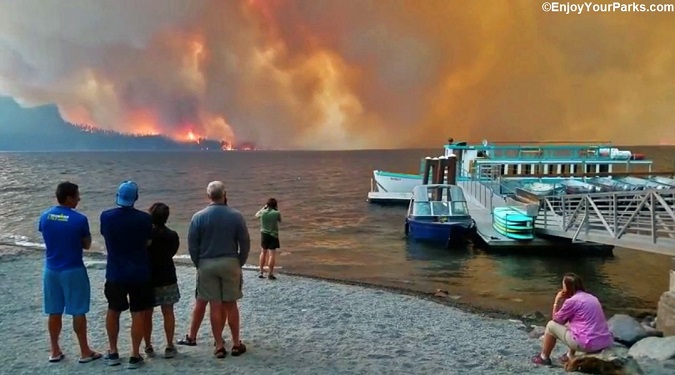
Visitors watching the Howe Ridge Fire from the shore at Lake McDonald Lodge on the evening of August 12, 2018. Just minutes after we shot this photo, the NPS evacuated the Lake McDonald Lodge.

The infamous "blow up" of the Howe Ridge Fire on the evening of August 12, 2018. 7 homes and over a dozen historic cabins burned to the ground.
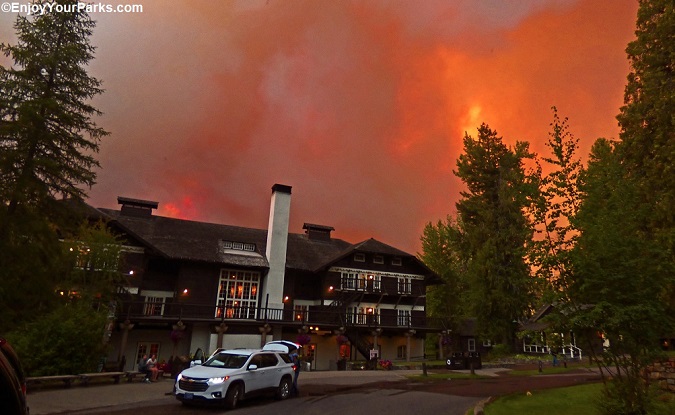
The evening Lake McDonald Lodge was evacuated due to the Howe Ridge Fire on August 12, 2018.
Interactive Map of Glacier Park Fires
Interactive Map of Glacier Park Fires (Click Here)
This fascinating map shows you the Glacier National Park forest fire history since the park was established in 1910. The modern fires such as the Reynolds Creek Fire, Sprague Fire and the Howe Ridge Fire have not yet been added to this informative map.
This is a screenshot of the NPS Interactive Map of Glacier Park Fires through the history of the park.
The Aftermath of a Glacier Park Wildfire
The aftermath of a Glacier Park wildfire depends on how "hot" the fire was. The ideal Glacier Park fire is one that cleans out the understory (brush/undergrowth) underneath the mature evergreens, and spares the large healthy mature trees. This is what we all wish for when Glacier Park is hit with a wildfire, but it's not always the case. If there is enough fuel (forest), and the fuel is unusually dry, and the air temperature is hot and the relative humidity is low, this is a recipe for a really "hot" fire, which results in the "incineration" and "sterilization" of the area... leaving nothing living and killing even the seeds deep within the ground that were designed to open up due to the heat of the fire. These "hot" Glacier Park fires are destructive and devastating, and it takes sometimes hundreds of years for an area to return to what it was prior to the wildfire.
An example of a "hot" Glacier Park is the Red Eagle Fire of 2006. Large tracts of forest were burned so badly that even 12 years later there is not a sign of an evergreen beginning to grow. Below is a photo we took during the fall of 2018 to illustrate just how long it takes for the area to recover from one of these "hot" Glacier Park fires...
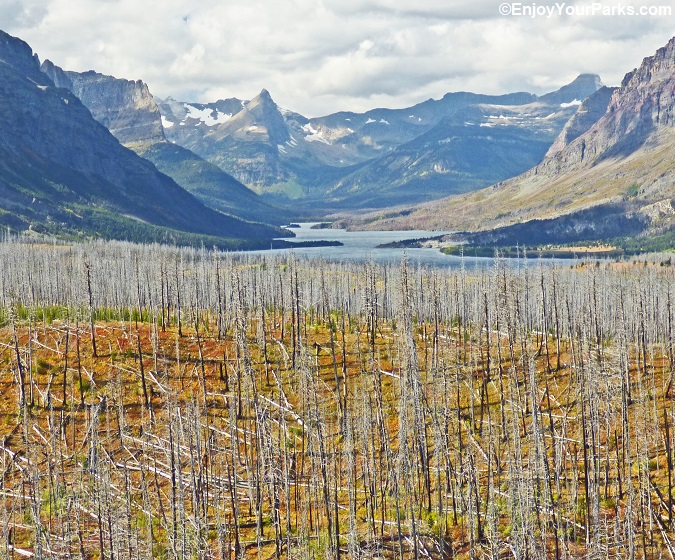
Photo taken on September 15, 2018... Twelve years after the Red Eagle Fire scorched the area near St. Mary during the summer of 2006.
Extreme Example: The Kenow Fire of 2017 in Waterton Lakes National Park.
The Kenow Fire of 2017 was one of the more destructive fires the West has ever seen. In just 4 hours, the fire grew nearly 50,000 acres in Waterton Lakes National Park, incinerating everything in its path. The fire was moving over 40 miles an hour up the gorgeous heavily forested Akamina Parkway, leaving nothing in its path. The entire parkway is now basically a "moonscape", and fire officials feel that because the fire was so hot, killing even the deepest seeds, that this once heavily forested parkway will not see another tree for nearly one thousand years!!!!! The Red Rock Parkway suffered a similar fate... and the large campground with hundreds of campsites was completely destroyed.
The Kenow Fire burned over 80% of the Waterton Lakes National Park forests, which includes the vast majority of the trail systems as well. It will take many years for the park to even remotely recover, and are hearts are deeply saddened for this amazing place.

The Akamina Parkway in Waterton Lakes National Park prior to the Kenow Fire of 2017. Experts predict this area will not see an evergreen for nearly one thousand years due to the extreme temperature of this horrific fire.
Below is a photo we snapped of a section of the Howe Ridge Fire (2018) that is located just across from Lake McDonald Lodge. This was the first day visitors we allowed back into the area. To us, this looks like an extremely hot wildfire aftermath, but time will tell...

Aftermath of the 2018 Howe Ridge Fire. This photo was taken September 21, 2018.
So the bottom line is this: NOT ALL FIRES ARE GOOD FIRES. Some fires are very good for the health of a forest, but in other cases the fire is so hot and so destructive that no good comes of it.
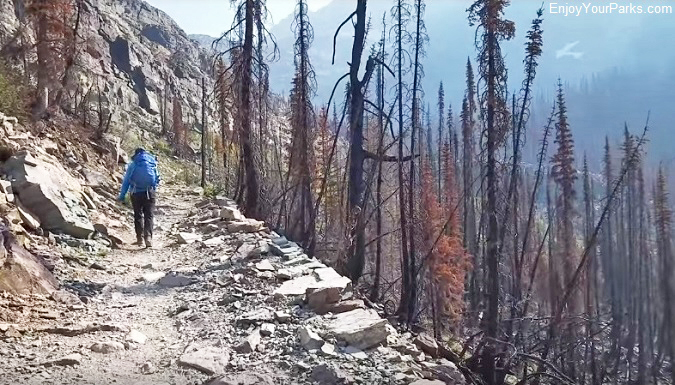
Shannon hiking up the Sperry Trail, one year after the Sprague Fire of 2017 ravaged the area.
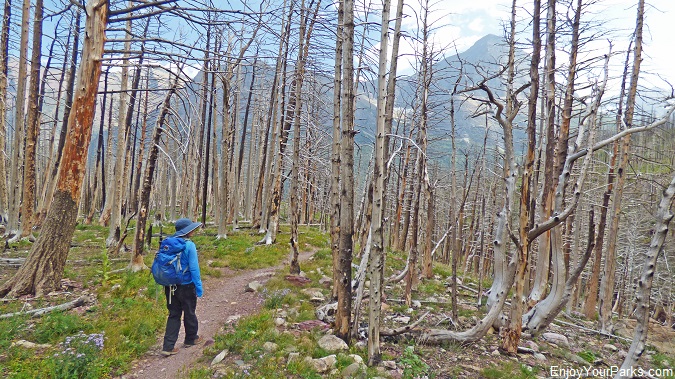
Shannon hiking on the Siyeh Pass Trail near Sunrift Gorge in July of 2018.. through the Reynold Creek Fire that burned the area in the summer of 2015.
HOW TO ENJOY GLACIER NATIONAL PARK DURING THE FIRE SEASON
When is the Air the Clearest in Glacier Park?
Typically, the air quality in Glacier National Park is remarkably pristine during the months of June and July. The sky is the classic vivid blue that you see on all the post cards, and the clarity of the mountains, even at long distances, is so clear that it takes your breath away. July is when we do most of our hiking and mountain climbing, as we are assured fantastic photographs due to the clear air.
The summer of 2018 marked the start of the rebuilding process of the Sperry Chalet after it being destroyed by the Sprague Fire the year before. The main short term goal for the 2018 season was to get the new roof on before winter. We actually visited the chalet on August 9, 2018 to see how the rebuilding was going. But on August 11, 2018, another series of dry lightning strikes ignited several fires in and around Glacier Park, which included the Howe Ridge Fire at Lake McDonald. Before the first day was over, the Howe Ridge Fire blew up along the west side of Lake McDonald, destroying 7 homes and over a dozen historic cabins including Kelly’s Camp and the Wheeler Cabin. The author is writing this as 14 days has now passed, and it is now 11,000 acres and only 10% contained. Other fires include the Paola Ridge Fire along U.S. Highway 2 near Essex Montana, the Whale Butte Fire west of Kintla Lake in the North Fork Area, the Coal Ridge Fire west of Polebridge Mercantile and the Boundary Fire near Goat Haunt Montana and Upper Waterton Lake. These fires will also slow down the rebuilding of the Sperry Chalet, as helicopters needed for supply drops will be now needed for fire fighting.
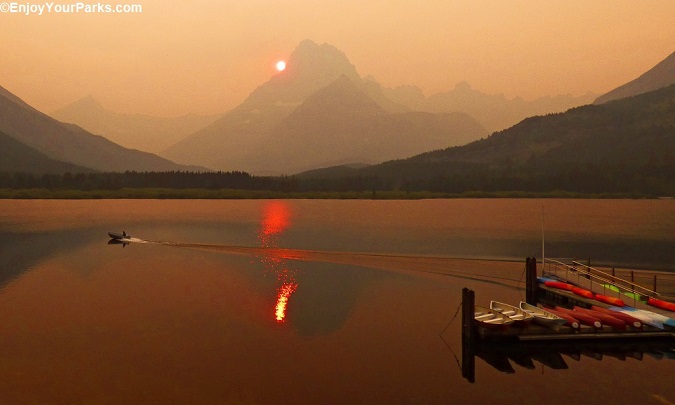
A smoky evening at Many Glacier: A view from the Many Glacier Hotel Deck.
When Does the Fire Season Start in Glacier Park?
Then, usually sometime in early August, the first fires begin to burn... usually not in the park but in the direction of the prevailing west wind, so during certain days, the air quality begins to diminish. Even a fire on the West Coast can affect the air quality of Glacier Park. But early on, there are still clearer days than smoky days, and most visitors are still having a great time in Glacier Park. Only picky photographers like ourselves notice that the air quality is not what it was just a few weeks earlier.
Now if a fire erupts just west of Glacier Park, for example near Libby Montana in the Northwest Corner of the State, then if the wind is wrong, the air quality drops dramatically and people driving the Going To The Sun Road will notice the smoky air. But if the wind is in your favor, the air will become crystal clear, provided there is no other fire in the direct line of the wind.
Know Where the Fires are Located, and Know the Wind Direction that is Favorable.
Even during the typical Northern Rocky Mountain Fire Season, visitors will enjoy clear days between the smoky days in Glacier Park, provided there is a wind direction that frees Glacier Park of smoke. The best thing for visitors to do is find out where the area fires are located, and then determine if there is a wind direction that will clear out the smoke for a day or so. Those particular days are the best to drive over the Going To The Sun Road, or go on a great hike like the Grinnell Glacier Trail.
The infamous "blow up" of the Howe Ridge Fire on the evening of August 12, 2018, when 7 homes and over a dozen historic cabins including Kelly's Camp and the Wheeler Cabin. Residents of the homes were told to evacuate at 8:00 pm, and the fire destroyed their homes by 9:00 pm. We watched it all from the shore of Lake McDonald Lodge. The Howe Ridge Fire was less than one day old.
Now if and when fires are ignited in Glacier National Park, these Glacier Park fires can still be handled in the same manner. Meaning, determine where the fire or fires are located, and determine if there is a favorable wind direction that will clear the area that you're interested in spending time in, of smoke.
Determine If there is a Smoke Free Area in Glacier Park: USE THE WEBCAMS!
What we mean by a "smoke free" area of Glacier Park is this... A great example was the Sprague Fire of 2017. This fire was located just southwest of the Going To The Sun Road, so more times than not, the entire Going To The Sun Road was smoky during the prevailing west wind. Day after day, visitors could barely even see a mountain across a valley along the Going To The Sun Road due to the smoke. HOWEVER, many of those days, especially if the wind was a northwest wind, the air in the Many Glacier Area remained quite clear, and visitors were enjoying gorgeous hikes and blue skies while everyone on the Sun Road couldn't see their hand in front of their face because of the heavy smoke coming from the Sprague Fire. Same was true for the Goat Haunt Area and the Two Medicine Area. So the bottom line is this: Check the NPS webcams and determine which areas of Glacier Park are the clearest.
The above screenshots are a classic example of just how important the wind direction is in Glacier Park during the Glacier park Fire Season. The Howe Ridge Fire, as well as three other major fires in and around the park to the west, were burning during the summer of 2018. When the wind was coming from the west (which is the prevailing wind direction) the entire park was horribly smoky. But on this particular day, the wind came from the south, and as you can see, Glacier Park had relatively clear air and people enjoyed the Sun Road as well as the many hiking trails throughout the park. So the moral to the story is this: Know where the fires are located, and know which wind direction will clear out the smoke temporarily. Now of course if you have the misfortune of fires burning in all directions, no matter which direction the wind is blowing, the air quality will more than likely be bad.
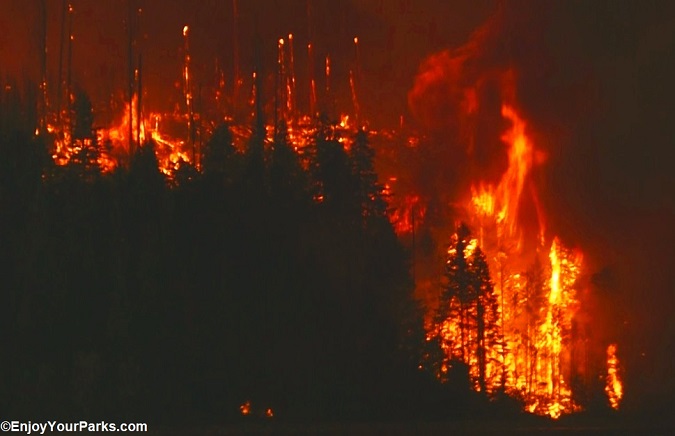
Howe Ridge Fire in Glacier Park, 2018.
When the Air Quality is Bad In Glacier Park, Is it Unhealthy to Breath?
The answer to this question is a resounding YES. When the air is really smoky where you can literally smell and taste it, NPS officials have said that it's like smoking a pack of cigarettes a day. And that's just if you're normally breathing it. Now if you're hiking or mountain climbing, you're going to be breathing much heavier, and therefore you are going to be taking in much more smoke. The solution? stay inside or stay in your car. Now the second best option is to at least wear a mask.

Here we are on Logan Pass heading for the Granite Park Chalet (with Shannon's sister) in September of 2017. The air quality was absolutely horrible that day due to the Sprague Fire. We had reservations to sleep sleep at the chalet, so we put on our masks and headed out.





